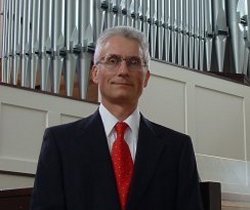
| | Organist | Accordionist | Composer | Conductor | Author | Educator |

 |
Henry Doktorski
|
 |
November 2003: Henry Doktorski appeared as guest accordionist with violinist Gil Shaham and the Pittsburgh Symphony Orchestra in two performances of Carlos Gardel's Por Una Cabeza arranged by John Williams. The concerts, on November 28 and 29, 2003 at the Heinz Center for the Performing Arts in Pittsburgh, Pennsylvania, were conducted by PSO music director Mariss Jansons.
Backstage: Henry Doktorski and Gil Shaham
with his 1699 "Countess Polignac" Stradivarius violin.Composed in 1935 by the great French-born Argentinean tango composer, singer and actor, Carlos Gardel (1890-1935), Por Una Cabeza bemoans the composer's lack of fortune, both in wagering on horses and love. This sensuous tango was featured in Gardel's 1935 film, Tango Bar, released three months before his tragic and untimely death in a plane crash. Nearly a half-century later, Por Una Cabeza became famous by its performance in the 1992 Hollywood film, Scent of a Woman, which starred actor Al Pacino.
In 1996, the composer John Williams (especially known for his Hollywood film scores), subsequently arranged Gardel's tango for solo violin and symphony orchestra (and accordion) and conducted violinist Itzhak Perlman and the Pittsburgh Symphony Orchestra (and Doktorski) in a recording which was released on the Sony Classical label (Cinema Serenade SK 63005). Cinema Serenade was a big hit and reached number one on the Billboard crossover chart.
John Williams' arrangement of Por Una Cabeza is scored for string orchestra with three flutes, three oboes, English horn, three clarinets, bass clarinet, three bassoons, contrabassoon, four horns, triangle, small triangle, tambourine, small tambourine, timpani, harp, piano, celeste and accordion.
Doktorski spoke about the first rehearsal:
I was told to sit in a chair in the back of the second violin section, and we played through the piece. As soon as it was finished, Maestro Jansons called out, "Mr. Accordion Player!" He beckoned me to come forward, "Please come up front and sit here. I can't hear you back there."
I guessed that the sound of my instrument had been absorbed by the first and second violinists; because the accordion sits on my lap, the sound was not able to pass over them. (Violinists, on the other hand, hold their instruments up high on their shoulders.) If my seat had been elevated, like the wind and brass players for instance, the accordion would probably have projected nicely into the audience.
I picked up my music and walked up front where Maestro Jansons and Gil Shaham greeted me. Maestro Jansons called for the stage manager to bring my chair and music stand to the front. In less than a minute, I was seated at center stage, directly behind and between the conductor and soloist, where my instrument could project clearly into the audience.
We played through the four-minute piece once more, and then stopped for a break. Mr. Shaham briefly chatted with me; he noted that the solo violin and accordion sometimes act in tandem, in an imitative fashion, and he complimented the beautiful sound of my instrument.
Years ago I had my accordion custom-tuned to A-440, the nearly-universal standard for orchestras. For some reason or another, probably to create a "folk music" sound, most accordions are factory-tuned sharp; one friend of mine who plays a concert bayan told me his instrument was factory-tuned to A-446. This may be fine for polka players who want their instrument to "cut through" a trumpet or saxophone section, but it makes the instrument practically unplayable with concert ensembles tuned to standard pitch.
For Por Una Cabeza, I chose to use my violin register: the stop which consists of two unison ranks of reeds, one of which is tuned slightly sharp to create a shimmering vibrato or, in pipe organ parlance, a vox celeste effect. In addition, I had my violin register custom-tuned very dry; the two reeds are tuned nearly to the same pitch. It is a very refined and beautiful sound, not jarring as in a wet-tuned instrument. Maestro Jansons confirmed my decision when I played a brief excerpt using my violin stop and then with my master stop. He remarked, "Yes, use the former; the latter is a little too coarse."
After the rehearsal, one of my friends in the cello section accosted me in the backstage hallway and quipped, "Henry! Good to have you play with us again. You're so amazing, I can't believe it. You just show up, and at the first rehearsal the Maestro calls you up front, and Gil Shaham, the world-famous violinist, shakes your hand and compliments you. What irony! I have been playing in the back of the cello section with this orchestra for twenty-five years, and no one has ever taken notice of, or complimented me!"
We both laughed, and I replied, "Perhaps, but you, despite your anonymity, make a helluva lot more money than me!"
At the final performance on Saturday, Maestro Jansons and Mr. Shaham decided to play Por Una Cabeza twice; once during the program, and again as an encore. The audience was thrilled and before Mr. Shaham left the stage, he shook my hand and said, "Thank you for playing the tango with me."
I replied, "The pleasure was mine." Indeed, it was.
|